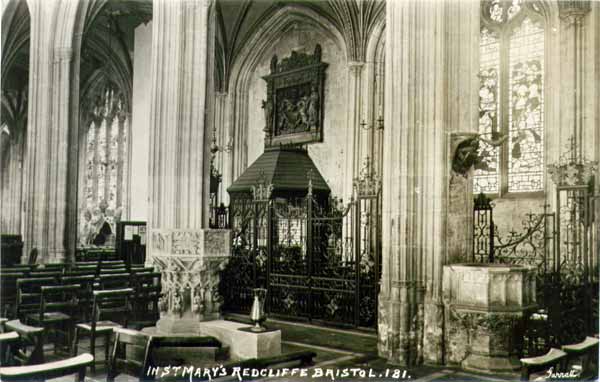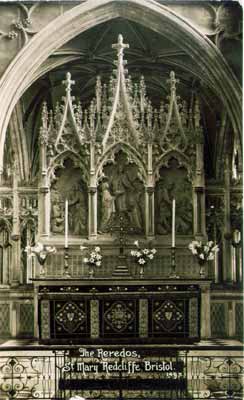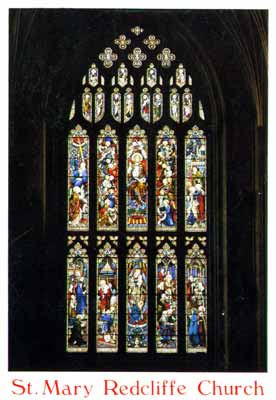
Bristol UK Postcards - St. Mary Redcliffe (2)

St. Mary Redcliffe - The Font
This unused postcard has just the printed text Garratt

St. Mary Redcliffe - Reredos
This unused postcard has the printed text...
V Series
Real Photograph
Viner & Co., Publishers, Bath
In the religious context, a reredos is a screen behind an altar. The reredos of St. Mary Redcliffe is relatively modern, having been erected in 1866-67. It was designed by George Godwin, who was architect of the church from 1845 to at least 1877. All except the three middle panels was carved by Mr. Rice. The whole of the altar and reredos is of Caen stone. The central panel is Christ blessing the loaves and the fishes. The panel on the right hand represents the distribution of the loaves and the one on the left the distribution of the fishes. These three panels were carved in London out of very fine Caen stone. The cost of the entire work was about £1,000.
Source: "Some notable altars in the Church of England and the American Episcopal Church" by John Wright, published by Macmillan, New York in 1908.

St. Mary Redcliffe - West Window
This unused postcard has the printed text...
C10318X
Judges Postcards Ltd., Hastings, England
Judges Postcards trademark logo
This is a wonderful church in the district of Redcliffe near Bedminster. I may be biased as I was christened here, but it really is a beautiful church. Queen Elizabeth I is famously said to have referred to it as "The fairest, goodliest and most famous Parish church in England". There was a church on this spot as early as the reign of Henry I (1100 - 1135), we know this as in 1115 he gave it to Salisbury Cathedral, but even before this there is a record of a priest in the Royal Manor of Bedminster.
The church was rebuilt between 1232 and 1246, this church was a lot larger than the earlier one, possibly not a lot smaller than the present one. A little later the church fell into disrepair and rebuilding was started by Simon de Burton, who went on to become mayor of Bristol three times. Progress was slow and by 1337 the work was being supervised by John Bohler, Thomas de Uphill and Geoffrey Fuller. In 1376 William Canynges more or less rebuilt it as the great church that stands today. The tomb of this great benefactor and his wife can be seen in the church. The church was very important in these days as the Merchant Venturers began and ended their voyages by praying at the shrine of Our Lady of Redcliffe, which was in the North Porch. William Canynges went on to become Mayor six times.
William Canynges' grandson also named William became Mayor in 1441 and repaired the church. In 1446 there was a great storm and, after being hit by lightning, the spire collapsed onto the nave. The damage was extensive and was repaired, with no expense spared and with great attention to detail. The spire is a late addition not reaching its present height of 292 feet until 1872. Before then the church was topped by a short turret like affair. This William Canynges became Mayor five times.
This page created 14th December 2009, last modified 11th February 2010